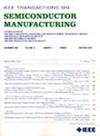VECSNet: A Nondestructive Automatic VCSEL Chip Detection Network With Pixelwise Segmentation
IF 2.3
3区 工程技术
Q2 ENGINEERING, ELECTRICAL & ELECTRONIC
引用次数: 0
Abstract
Dark line defects (DLDs) are critical factors that significantly limit the performance of vertical-cavity surface-emitting lasers (VCSELs). Recently, convolutional neural network (CNN)-based methods have shown strong feature extraction capabilities, achieving exceptional performance across various fields. However, these methods still face limitations on the segmentation samples with weak texture, varying shapes and blurred boundary information. To overcome these limitations, a novel segmentation method named VECSNet is proposed in this work. Electroluminescence imaging technology is employed to capture the emission characteristics of VCSELs and develop the corresponding dataset. To improve the extraction of emission features, a parallel dual-encoding structure is designed to capture both spatial and semantic information. Additionally, a feature fusion attention (FFA) block is introduced to effectively fuse features extracted from different branches. Faced with blurred boundary information, a boundary detector is proposed to guide each fusion connection in acquiring boundary feature information and enrich feature representation. Furthermore, to improve segmentation precision for areas with varying shapes, auxiliary logits are introduced to enhance discriminative ability of the network from multiple levels. Experimental results on the VCSEL emission segmentation dataset demonstrate that the proposed method achieves a high Dice score (92.5%) with fewer parameters (6.4M), outperforming other state-of-the-art segmentation approaches.基于像素分割的VCSEL芯片无损自动检测网络
暗线缺陷(dld)是制约垂直腔面发射激光器性能的重要因素。近年来,基于卷积神经网络(CNN)的方法显示出强大的特征提取能力,在各个领域都取得了优异的表现。但是,这些方法对于纹理弱、形状多变、边界信息模糊的分割样本仍然存在局限性。为了克服这些限制,本文提出了一种新的分割方法VECSNet。利用电致发光成像技术捕获vcsel的发射特性,并建立相应的数据集。为了改进发射特征的提取,设计了一种并行的双编码结构,同时捕获空间和语义信息。此外,引入特征融合注意(FFA)块,对不同分支提取的特征进行有效融合。面对模糊的边界信息,提出了一种边界检测器,引导各融合连接获取边界特征信息,丰富特征表示。此外,为了提高对不同形状区域的分割精度,引入了辅助逻辑,从多个层面增强了网络的判别能力。在VCSEL发射分割数据集上的实验结果表明,该方法以较少的参数(6.4M)获得了较高的Dice分数(92.5%),优于其他最先进的分割方法。
本文章由计算机程序翻译,如有差异,请以英文原文为准。
求助全文
约1分钟内获得全文
求助全文
来源期刊

IEEE Transactions on Semiconductor Manufacturing
工程技术-工程:电子与电气
CiteScore
5.20
自引率
11.10%
发文量
101
审稿时长
3.3 months
期刊介绍:
The IEEE Transactions on Semiconductor Manufacturing addresses the challenging problems of manufacturing complex microelectronic components, especially very large scale integrated circuits (VLSI). Manufacturing these products requires precision micropatterning, precise control of materials properties, ultraclean work environments, and complex interactions of chemical, physical, electrical and mechanical processes.
 求助内容:
求助内容: 应助结果提醒方式:
应助结果提醒方式:


